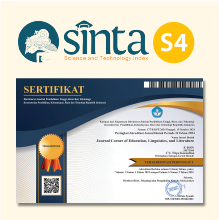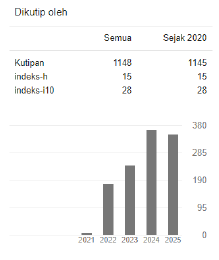A Multimodal Discourse Analysis on Female Representations in Film Posters
 https://doi.org/10.54012/jcell.v4i1.305
https://doi.org/10.54012/jcell.v4i1.305
 Abstract views: 3271
Abstract views: 3271
 PDF downloads: 2595
PDF downloads: 2595
Keywords:
applied linguistics, education, female representation, film posters, media, multimodal, online streaming sites, visual grammar, philippinesAbstract
This study aims to identify the multimodal features used in film posters of Filipino movies produced between 2010 and 2023 that are currently found on Netflix. It aims to highlight the various stereotypes of women depicted through various multimodal modes using Multimodal Discourse Analysis and anchored on Visual Grammar by Kress and Van Leeuwen and Systemic Functional Linguistics by Halliday. Moreover, through this study, the researcher examined how these representations affected female viewers’ construction of their feminine images and their overall impression on the film posters. There were 40 film posters analyzed and 11 female participants interviewed. The results revealed that the interactional (gaze, size of frame, and perspective), compositional meanings (salience and informational value) of the film posters were tools to display different female representations. Also, the representational meanings made up by vectors and different structures and process underscored different female representations. These representations were also observed in the themes that were developed from the responses of the participants, which include: women’s stereotypical image portrayal, progressive female characters, stereotype subversion, and objectification. Finally, the participants also had similar opinions regarding the influence that film posters have on them when choosing which movies to watch, and the most prominent visual elements that attract the viewers.
Downloads
References
Acharya, A., Prakash, A., Saxena, P., & Nigam, A. (2013). Sampling: Why and how of it. Indian Journal of Medical Specialtie. Indian Journal of Medical Specialties, 4(2), 330-333.
Aley, M., & Hahn, L. (2020). The powerful male hero: A content analysis of gender representation in posters for children's animated movies. Sex Roles, 83(7-8), 499-509.
Amores, J., Arcila-Calderón, C., & González-de-Garay, B. (2020). The gendered representation of refugees using visual frames in the main Western European media. Gender issues, 37(4), 291-314.
Ancheta, J. (2016). Dissecting the image of Elsa towards semiotic reading of the Philippine classic film ‘Himala. Jurnal Komunikasi-malaysian Journal Of Communication, 33(2), 770-789.
Arauna, T., & Tarragona, I. (2013). Advertising stereotypes and gender representation in social networking sites. Scientific Journal of Media Education, 4(1), 177-186.
Asghar, B., Azher, M., & Fatima, S. (2022). Gender portrayal on cover pages of Pakistani English children’s literature: A visual semiotic analysis. Journal of Gender and Social Issues. .
Bakhtiari, M., & Salimi, F. (2014). Evolution of the female roles in the US (Case study: The Hollywood movies in the late 1970s and early 1980s). International Journal of Women's Research, 3(2), 185-203.
Belgrimet, S., & Rabab’ah, G. (2021). A multimodal discourse analysis of English posters in violence. Theory and Practice in Language Studies, 11(2), 191. doi:https://doi.org/10.17507/tpls.1102.12
Cao, Y., Han, C., & Hale, A. (2021). She is like a Yakshini’: Character construction via aggressive humour in Chinese sitcom discourse. The European Journal of Humour Research, 9(4), 110-130.
Chen, Y., & Gao, X. (2014). Interpretation of movie posters from the perspective of multimodal discourse analysis. GSTF Journal on Education (JEd), 1(1).
Colin, L., & Bissell, K. (2014). Beauty ideals in the checkout aisle: Health-related messages in women's fashion and fitness magazines. Journal of Magazine Media, 2.
Creswell, J., & Creswell, J. (2018). Research design: qualitative, quantitative, and mixed methods approaches. Sage.
de Weert, S. (2021). Old stereotypes, new media. The representation of female terrorists in alternative news media.
Du Gay, P., Hall, S., Madsen, A., Mackay, H., & Negus, K. (2013). Doing cultural studies: The story of the Sony Walkman. Sage.
Fong, Y., & Nyathi, S. (2019). Gender representation and framing of Malaysian women: A study of feature articles in female magazine. Journal of Content, Community and Communication, 10(9), 29-38.
Goldman, A., & Waymer, D. (2014). Identifying ugliness, defining beauty: A focus group analysis of and reaction to Ugly Betty. Qualitative Report, 19(10).
Grover, S., & Hundal, B. (2014). A socio-cultural examination of gender role: A study of projection of women in advertisement . Gurukul Business Review, 10, 54-63.
Hogg, M., & Vaughan, G. (2017). Social Psychology. Pearson.
Jewitt, C. (. (2009). The Routledge handbook of multimodal analysis (Vol. 1). Routledge.
Jewitt, C., Bezemer, J., & O'Halloran, K. (2016). Introducing multimodality. Routledge.
Jha, A. (2020). The representation of gender in Bollywood film posters: A semiotic analysis. Global Media Journal: Indian Edition, 12(2).
Koka, N. (2020). The Evolution of Feminism in Film: How the Last Decade (2010-2019) Became the Turning Point for Female. [Doctorate dissertation, Department of Modern Languages and Cultures]
Kress, G. (2009). Multimodality: A social semiotic approach to contemporary communication. Routledge.
Kress, G. (2011). Discourse analysis and education: A multimodal social semiotic approach. Dalam An introduction to critical discourse analysis in education (hal. 205-226). Routledge.
Kress, G., & Van Leeuwen, T. (2006). Reading images: the grammar of visual design. Routledge.
Ledin, P., & Machin, D. (2020). Introduction to multimodal analysis. Bloomsbury.
Machin, D. (2007). Introduction to multimodal analysis. Hodder Arnold.
Manon, G. (2021). We are not born submissive : How patriarchy shapes women’s lives. Princeton University Press.
Matos, C. (2016). Globalization, gender politics, and the media: From the West to Latin America. Lexington Books.
Mulvey, L. (2013). Visual pleasure and narrative cinema. In feminism and film theory (hal. 57-68). Routledge.
Nguyen, T. T. (2021). A multimodal discourse analysis of romantic comedy movie posters. NU Journal of Foreign Studies, 37(3).
Nurudeen, M., Ogungbe, E., & Zakariyah, M. (2021). A socio semiotic approach to multimodal discourse of selected Nollywood film advertisement posters. Studies in Pragmatics and Discourse Analysis, 2(2), 31-45.
Patria, A., Kristiana, N., & Aryanto, H. (2019). Comedy film posters in the 70’s Era: content analysis of changing trends. In Social Sciences, Humanities and Education Conference (SoSHEC 2019) (hal. 172-177). Atlantis Press.
Pawitan, Z., & Fetrianggi, R. (2021). Representation of Muslim women in Indonesian film posters with Islamic nuance. 3rd International Conference on Arts and Design Education (ICADE 2020) (hal. 125-128). Atlantis Press. doi:10.2991/assehr.k.210203.027
Peng, Z. (2022). Multimodal discourse analysis of movie posters from the perspective of visual grammar—A case study of "hi, mom. Theory and Practice in Language Studies, 12(3), 605-609.
Ping, K. (2018). A visual grammar analysis of Lesaffre’s website. Advances in Language and Literary Studies, 9(6), 38-41.
Pooranalingam, S. (2024). Film poster design: Understanding film poster designs and the compositional similarities within specific genres. Spectrum, 12.
Prieler, M., & Centeno, D. (2013). Gender representation in Philippine television advertisements. Sex Roles, 69, 276-288.
Rapanot, C., Paragas, F., Mangalus, M., Hoggang, C., & Agonos, M. (2020). Reading gender by the column inch: Analyzing gender representation in Philippine print advertisements. Plaridel, 18(1), 265-293.
Saniel, J. J. (2018). Conceptualizations on femininity and identified issues in women. In Fifth International Conference on Women & Gender Studies 2018 , 80.
Song, Y. (2022). Research on male gaze in mass media opinion guidance from the perspective of feminism. BCP Business & Management, 313-317. doi:https://doi.org/10.54691/bcpbm.v31i.2598
Steiner, L. (2014). Feminist media theory . The handbook of media and mass communication theory, 359-379
Stokmans, M. (2015). Effectiveness of promotional film posters. In Proceedings of the 10th International Conference on Arts and Cultural Management, 28.
Subedi, K. (2021). Determining the sample in qualitative research. Scholar's Journal, 4, 1-13. doi:10.3126/scholars.v4i1.42457
Sun, F. (2017). Meaning constructed by images in cross-border e-business websites-A case study in China from social-semiotic perspective. In 2017 2nd International Conference on Education, Management Science and Economics (hal. 180-183). Atlantis Press.
Tao, Y. (2022). On the multi-dimensional relationship of visual symbols in film posters. In 2021 International Conference on Culture, Design and Social Development (CDSD 2021) (hal. 379-382). Atlantis Press.
Tartaglia, S., & Rollero, C. (2015). Gender stereotyping in newspaper advertisements: A cross-cultural study. Journal of Cross-Cultural Psychology, 46(8), 1103-1109.
Wang, R., & Liu, Z. (2023). Stereotypical representations of female characters in film and television in the context of the male gaze and their breakthrough. Transactions on Social Science, Education and Humanities Research(1), 322-329.
Wang, Y., Tlili, A., Hosny, S., Zhao, J., Li, Z., Shehata, B., & Huang, R. (2023). If images could speak: A social semiotics analysis of gender representation in science textbook images. Journal of Curriculum Studies, 55(4), 471-488.
Whitenton. (2021). Triangulation: Get better research results by using multiple UX methods. Nielsen Normal Group.
Yin, L., & Hassan, H. (2021). Multimodal discourse analysis of the movie poster little big soldier. International Journal of Languages, Literature and Linguistics, 7(3), 101-105.
Zhang, C. (2017). Multimodal discourse analysis of advertising language. Dalam Proceedings of 4th International Conference on Education, Language, Art and Intercultural Communication (ICELAIC 2017) (hal. 169-172). Atlantis Press. doi:10.2991/icelaic-17.2017.37
Zhao, J. (2023). A multi-modal discourse analysis of the film poster no more bets from the perspective of visual grammar. Frontiers in Art Research, 5(17). doi:https://doi.org/10.25236/far.2023.051713
Downloads
Published
How to Cite
Issue
Section
License
Copyright (c) 2024 Ana Louella N. Navarro, Teresita Q. Adriano

This work is licensed under a Creative Commons Attribution-ShareAlike 4.0 International License.
All articles published in the Journal Corner of Education, Linguistics, and Literature are licensed under the Creative Commons Attribution-ShareAlike License (CC BY-SA).

















